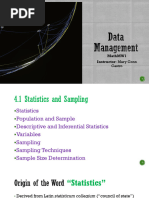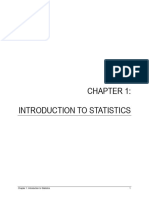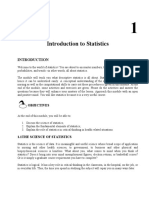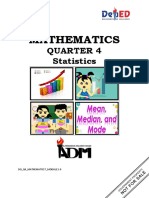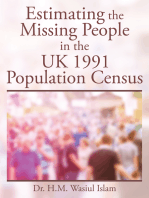CTR 3 - Statistical Analysis With Software Application: I. Topic II. Learning Objectives/ Outcomes
CTR 3 - Statistical Analysis With Software Application: I. Topic II. Learning Objectives/ Outcomes
Uploaded by
I am JacobCopyright:
Available Formats
CTR 3 - Statistical Analysis With Software Application: I. Topic II. Learning Objectives/ Outcomes
CTR 3 - Statistical Analysis With Software Application: I. Topic II. Learning Objectives/ Outcomes
Uploaded by
I am JacobOriginal Title
Copyright
Available Formats
Share this document
Did you find this document useful?
Is this content inappropriate?
Copyright:
Available Formats
CTR 3 - Statistical Analysis With Software Application: I. Topic II. Learning Objectives/ Outcomes
CTR 3 - Statistical Analysis With Software Application: I. Topic II. Learning Objectives/ Outcomes
Uploaded by
I am JacobCopyright:
Available Formats
CTR 3 – Statistical Analysis with Software Application
I. Topic: Basic Concepts of Statistics
II. Learning Objectives/ Outcomes
At the end of the module, you should be able to
1. define statistics.
2. describe the two main branches of statistics.
3. classify data as qualitative or quantitative.
4. describe the difference between sample and population
5. identify the level of measurement of a data set
CTR 3 Ferdinand T. Pinugu
III. Pre-Assessment
The following test aims to determine your prior knowledge about the topic. Try to answer the
problems before reading the lesson.
I. Determine whether the statement is true or false. If it is false, rewrite it as a true statement.
1. A statistic is a measure that describes a population characteristic.
2. A sample is a subset of a population.
3. Inferential statistics involves using a population to draw a conclusion about a
corresponding sample.
4. A population is the collection of some outcomes, responses, measurements, or counts
that are of interest.
5. It is impossible for Philippines Statistics Authority to obtain all the census data about the
population of the Philippines.
6. A sample statistic will not change form sample to sample.
7. Data at the ordinal level are quantitative only.
8. For data at the interval level, you cannot calculate meaningful differences between data
entries.
9. More types of calculation can be performed with data at the nominal level than with
data at the interval level.
10. Data at the ratio level cannot be put in order.
II. Determine whether the data set is a population or a sample
1. The number of televisions in each household in the Philippines
2. The final score of each golfer in a tournament
3. The age of every third person entering SM mall
4. The political party of every Philippine president
5. The soil contamination levels at 10 locations near a landfill
III. Tell whether the data are qualitative or quantitative.
1. Telephone numbers in a directory
2. Body temperature of patients
3. Lengths of songs on MP3 player
4. Eye colors of models
5. Species of trees in a forest
6. Wait times at a grocery store
7. Responses on an opinion poll
8. Weights of infants at a hospital
9. Player numbers for a basketball team
10. Student ID numbers
IV. Determine the level of measurement of each data set.
1. Rankings (1st, 2nd, etc) of universities
2. Distances (in km) traveled by students commuting to school
3. Number of students in favor of school uniforms
4. SSS numbers of a group of teachers
5. Sex of users of a website
CTR 3 Ferdinand T. Pinugu
IV. Lesson Opening
Congratulations! You are about to begin your study of statistics. But why do you have to learn
statistics? Statistics provides you with methods for making better sense of the numbers used every day
to describe or analyze the world we live in. As you progress through the course, you should discover
how to use statistics in your everyday life and in your career. The prerequisite for this course is a little bit
of algebra, an open mind, and, of course, a willingness to study.
V. Guiding Questions
1. What is statistics?
2. What are the two main branches of statistics?
3. What are the different ways of classifying data?
4. Why is sample more often used than a population?
5. What is the difference between a parameter and statistic?
CTR 3 Ferdinand T. Pinugu
VI. Discussion/Lesson Proper
Basic Vocabulary of Statistics
Definition of Statistics
When you hear the word statistics, what comes probably to your mind are bunch of numbers. But
statistics is not purely about numbers. It is how numbers are transformed into useful information. In a
broader sense, statistics is defined as the art and science of collecting, analyzing, presenting, and
interpreting data.
Types of Statistics
The field of statistics can be subdivided into two areas: descriptive statistics and inferential statistics.
Descriptive statistics is what most people think of when they hear the word statistics. It consists of
methods for organizing, displaying, and describing data by using tables, graphs, and summary measures.
The objective is to summarize some of the important features of a set of data.
Inferential statistics consists of methods that the sample results to help make decisions or predictions
about a population. It is concerned with the formulation of conclusions or generalizations about a
population based on an observation or a series of observations of a sample drawn from the population.
Population versus Sample
We will often encounter the terms population and sample as we move on to our future topics.
Consequently, understanding the meaning of each of these two terms and the difference between them
is crucial.
Suppose a statistician is interested in knowing
1. The percentage of all COVID-19 positive cases in Region 2 who are from Isabela
2. The 2019 gross sales of all companies in Cauayan City
3. The prices of all houses in Santiago City
In these examples, the statistician is interested in all COVID-19 positive cases, all companies, and all
houses. Each of these groups is called the population for the respective example.
In statistics, a population does not necessarily mean a collection of people. It can, in fact, be a
collection of people or of any kind of item such as houses, books, television sets, or cars. The
population of interest is usually called the target population.
A population consists of all elements – individuals, items, or objects – whose characteristics are being
studied. The population that is being studied is also called the target population.
Most of the time, decisions are made based on portions of population because it is impossible to
include all members of the population. For example, the election polls conducted to estimate the
percentages of Filipino voters who favor various candidates in presidential elections are based on only a
few hundred or a few thousand voters selected from across the country. In this case, the population
consists of all registered voters in the Philippines. The sample is made up of a few hundred or few
thousand voters who are included in the poll.
A portion of the population selected for study is referred to as a sample.
CTR 3 Ferdinand T. Pinugu
EXAMPLE 1
Determine whether the data set is a population or a sample.
1. The height of each player on a school’s basketball tea
2. The amount of energy collected from every wind turbine on a wind farm
3. A survey of 500 spectators from a stadium with 45,000 spectators
4. The annual salary of each pharmacist at a pharmacy
5. The cholesterol levels of 20 patients in a hospital with 100 patients.
Solution
Items 1, 2, and 4 are population. Items 3 and 5 are sample.
Parameter versus Statistic
Related to population and sample are the terms parameter and statistic.
A parameter is a numerical measurement describing some characteristic of a population.
EXAMPLE 2
The “average” age of all time of admission for all students who have ever attended our school and the
“proportion” of students who were older than 21 years of age when they entered college are examples
of population parameters. The parameters “average” and “proportion” describes the entire population.
Often a Greek letter is used to symbolize the name of a parameter. For instance, the Greek letters μ,
and σ are the symbols for the parameters mean (or average) and standard deviation, respectively.
For every parameter there is a corresponding sample statistic.
A statistic is a numerical measurement describing some characteristic of a sample.
EXAMPLE 3
The “average” height, found by using the set of 25 heights, is an example of a sample statistic because it
refers to a sample.
Most sample statistics are found with the aid of formulas and are typically assigned symbolic names that
are letters of the English alphabet. For example, for the sample statistics mean and standard deviation
the symbols used are x and s, respectively.
It is important to note that a sample statistic can differ from sample to sample whereas a population is
constant for a population.
Quantitative versus Qualitative Data
Data is a term used to describe information that are derived from some form of measurement
(counting, using a standard scale, sorting into categories, rank ordering, and so on). You can classify data
as either quantitative or qualitative.
Quantitative data are counts or measurements for which representation on a numerical scale is
naturally meaningful.
Qualitative data consists of labels, category names, ratings, rankings, and other classifications for which
representation on a numerical scale is not naturally meaningful.
CTR 3 Ferdinand T. Pinugu
Distinguishing data as quantitative or qualitative is an important skill in statistics.
EXAMPLE 4
Classify the data as quantitative or qualitative.
1. Daytime temperature readings (in degrees Celsius) in a 30-day period
2. Heights (in centimeters) of plants in a plot of land
3. Satisfaction ratings (on a scale from “not satisfied” to “very satisfied”) by users of a website
4. Number (1, 2, and so on) of people attending a conference
5. Party affiliation of a candidate
Solution
Items 1, 2, and 4 are quantitative while items 3 and 5 are qualitative.
Discrete versus Continuous Data
You can further classify quantitative data as discrete or continuous.
Discrete data are quantitative data that are countable using finite count, such as 0, 1, 2, and so on.
Continuous data are quantitative data that can take on any value within a range of values on a
numerical scale in such a way that there are no gaps, jumps, or other interruptions.
EXAMPLE 5
Classify the data as discrete or continuous.
1. Number of people attending a conference
2. Ages (in years) of participants in a survey
3. Number of male children in a family
4. Heights (in inches) of plants in a plot of land
Solution
1. Discrete, because number of people (0, 1, 2, and so on) is count data.
2. Continuous, because ages can assume any value within a range of values on a numerical scale.
For example, a person could be 5 ½ years old or 45.33 years old.
3. Discrete, because number of male children is count data.
4. Continuous, because heights can assume any value within a range of values on a numerical
scale.
Levels of Measurement
Determining the level of measurement of a set of data is commonly the first step in a statistical process.
The foul levels of measurements are nominal, ordinal, interval, and ratio. These levels are hierarchical,
ranging from the nominal level, the lowest level of measurement, to ration level, the highest level of
measurement – and with higher levels also possessing the characteristics of lower levels.
The nominal level of measurement is characterized by data that consists of names, labels, or
categories only. The data cannot be arranged in an ordering scheme.
Example: gender, civil status, nationality, religion, etc.
CTR 3 Ferdinand T. Pinugu
The ordinal level of measurement involves data that may be arranged in some order, but
differences between data values either cannot be determined or are meaningless.
Example: good, better or best speakers; 1 star, 2 star, 3 star movie; employee rank
The interval level of measurement is like the ordinal level, with the additional property that
meaningful amounts of differences between data can be determined. However, there are no
inherent (natural) zero starting point.
Example: body temperature, year (1955, 1843, 1776, 1123, etc.)
The ratio level of measurement is the interval modified to include the inherent zero starting
point. For values at this level, differences and ratios are meaningful.
Example: weights of plastic, lengths of movies, distances traveled by cars
CTR 3 Ferdinand T. Pinugu
VII. Generalization/Summary
After studying the module, I have learned the following:
CTR 3 Ferdinand T. Pinugu
VIII. Post Assessment
This is the same test in the Pre-assessment. After reading the module, you should now be able
answer the items. You shall submit your answers to these items after one week.
I. Determine whether the statement is true or false. If it is false, rewrite it as a true statement.
1. A statistic is a measure that describes a population characteristic.
2. A sample is a subset of a population.
3. Inferential statistics involves using a population to draw a conclusion about a
corresponding sample.
4. A population is the collection of some outcomes, responses, measurements, or counts
that are of interest.
5. It is impossible for Philippines Statistics Authority to obtain all the census data about the
population of the Philippines.
6. A sample statistic will not change form sample to sample.
7. Data at the ordinal level are quantitative only.
8. For data at the interval level, you cannot calculate meaningful differences between data
entries.
9. More types of calculation can be performed with data at the nominal level than with
data at the interval level.
10. Data at the ratio level cannot be put in order.
II. Determine whether the data set is a population or a sample
1. The number of televisions in each household in the Philippines
2. The final score of each golfer in a tournament
3. The age of every third person entering SM mall
4. The political party of every Philippine president
5. The soil contamination levels at 10 locations near a landfill
III. Tell whether the data are qualitative or quantitative.
1. Telephone numbers in a directory
2. Body temperature of patients
3. Lengths of songs on MP3 player
4. Eye colors of models
5. Species of trees in a forest
6. Wait times at a grocery store
7. Responses on an opinion poll
8. Weights of infants at a hospital
9. Player numbers for a basketball team
10. Student ID numbers
IV. Determine the level of measurement of each data set.
1. Rankings (1st, 2nd, etc) of universities
2. Distances (in km) traveled by students commuting to school
3. Number of students in favor of school uniforms
4. SSS numbers of a group of teachers
5. Sex of users of a website
CTR 3 Ferdinand T. Pinugu
IX. Feedback
You can write your questions, observations, or recommendations here. Do you have any
questions about the lesson? Do you have any suggestions on how to improve the presentation
of the lesson?
X. References
- Berenson, M. L., et al. Basic Business Statistics: Concepts and Applications, 12th ed. New Jersey,
Prentice Hall, 2012.
- Mann, Prem S. Introductory Statistics, 7th ed. Massachusetts, John Wiley and Sons, 2010.
- Mendenhall, W., et al. Introduction to Probability and Statistics, 13th ed. Brooks/Cole, Cengage
Learning, 2009.
10
CTR 3 Ferdinand T. Pinugu
You might also like
- Statistical Analysis With Software Application PDFDocument126 pagesStatistical Analysis With Software Application PDFFeeling W8ter100% (10)
- MCQ - Intro To AuditDocument13 pagesMCQ - Intro To Auditemc2_mcv75% (28)
- 30 Days Python ProgrammingDocument250 pages30 Days Python Programmingendhy_aziz100% (1)
- Summary of Gary King, Robert O. Keohane & Sidney Verba's Designing Social InquiryFrom EverandSummary of Gary King, Robert O. Keohane & Sidney Verba's Designing Social InquiryNo ratings yet
- DCMotors DesignGuideDocument12 pagesDCMotors DesignGuidenaruto256No ratings yet
- Husqvarna Bar & Chain Fit Up Chart: Chainsaw ModelDocument1 pageHusqvarna Bar & Chain Fit Up Chart: Chainsaw ModelAbdullahNo ratings yet
- Statistical Analysis With Software ApplicationDocument126 pagesStatistical Analysis With Software ApplicationKryzzel Anne Jon100% (2)
- CCNA 3 Case Study Spring 2022Document7 pagesCCNA 3 Case Study Spring 2022Mohammed El-SaadiNo ratings yet
- Afar Millan Partnership Liquidation Chap 4Document13 pagesAfar Millan Partnership Liquidation Chap 4I am JacobNo ratings yet
- Affiliate Marketing Verticals Guide PDFDocument89 pagesAffiliate Marketing Verticals Guide PDFLeonNo ratings yet
- Address Map ZR90 - A1 Gen 1 Gateway Mod (S904899)Document10 pagesAddress Map ZR90 - A1 Gen 1 Gateway Mod (S904899)leorio88100% (1)
- EDAD 202/ FVE 202: Statistics in EducationDocument37 pagesEDAD 202/ FVE 202: Statistics in EducationJonathan Delos SantosNo ratings yet
- 4.1 Statistics and SamplingDocument72 pages4.1 Statistics and SamplingjayemarclabbuananNo ratings yet
- Statistical Reviewer Midterm 1Document22 pagesStatistical Reviewer Midterm 1Roxane EsabinianoNo ratings yet
- Module 1 2Document19 pagesModule 1 2AnthonyNo ratings yet
- Module 1Document10 pagesModule 1Tess LegaspiNo ratings yet
- Managerial Stat - Lecture Note New UuDocument81 pagesManagerial Stat - Lecture Note New UumoybonNo ratings yet
- ST130 - Chapter 1Document12 pagesST130 - Chapter 1Shikha NandNo ratings yet
- Random Variables and Probability DistributionsDocument68 pagesRandom Variables and Probability Distributionscriselda macabuhayNo ratings yet
- Introduction To Statistics: ObjectivesDocument14 pagesIntroduction To Statistics: ObjectivesRosemarie AlcantaraNo ratings yet
- Introduction To Statistics: ObjectivesDocument19 pagesIntroduction To Statistics: ObjectivesJanna AlardeNo ratings yet
- Introduction To StatisticsDocument60 pagesIntroduction To StatisticsLaiba ZahirNo ratings yet
- Stat Factsheet Latest Edition in The Descriptive PartDocument134 pagesStat Factsheet Latest Edition in The Descriptive PartNorjehanie AliNo ratings yet
- Unit IDocument106 pagesUnit IAnton Zed50% (2)
- MODULE 1 Stat by PSADocument23 pagesMODULE 1 Stat by PSAJayMarieZabanalNo ratings yet
- Chapter 1 Episode 1 - Introduction To Statistics in EducationDocument4 pagesChapter 1 Episode 1 - Introduction To Statistics in EducationAngel Ruby NovioNo ratings yet
- Chapter 1 Nature of StatisticsDocument10 pagesChapter 1 Nature of Statisticsjohnrhyzenlugod22No ratings yet
- Module 1Document7 pagesModule 1jntvtn7pc9No ratings yet
- Module 1Document16 pagesModule 1chelsea micaela perezNo ratings yet
- Introduction Lecturer NotesDocument7 pagesIntroduction Lecturer NotesVictoria SimwanzaNo ratings yet
- Fund-Statistics CorrectedVersionDocument305 pagesFund-Statistics CorrectedVersionPuvi YarasanNo ratings yet
- Module 1 PDFDocument6 pagesModule 1 PDFyoonginismNo ratings yet
- Module 2 LectureDocument15 pagesModule 2 LectureFrance MoNo ratings yet
- Basic of StatisticsDocument83 pagesBasic of StatisticsMuhammad Syiardy100% (1)
- AE 9- CHAPTER 1-2Document47 pagesAE 9- CHAPTER 1-2PeleNo ratings yet
- Educ 502 1 1Document70 pagesEduc 502 1 1david rentoriaNo ratings yet
- STT041 and STT041.1 PDFDocument59 pagesSTT041 and STT041.1 PDFHayrah Lawi100% (2)
- Lesson 1 (First Part) PDFDocument38 pagesLesson 1 (First Part) PDFJimmy BeastNo ratings yet
- Probability Statistics Section 1.1 NotesDocument29 pagesProbability Statistics Section 1.1 Notessirajahmed18905No ratings yet
- Elementary StatisticsDocument10 pagesElementary StatisticsJeorge HugnoNo ratings yet
- 1 Nature of StatisticsDocument7 pages1 Nature of StatisticsJay SerdonNo ratings yet
- Lecture - MODULE 1 LESSON 1Document15 pagesLecture - MODULE 1 LESSON 1Wander LustNo ratings yet
- KS3 G7 ADM Q4 Module1-9-For-PrintingDocument40 pagesKS3 G7 ADM Q4 Module1-9-For-PrintingMichelle LaurenteNo ratings yet
- W1 StatisticsDocument85 pagesW1 StatisticsNissi Canillo LumantasNo ratings yet
- STAT112 WEEK 1 NoteDocument23 pagesSTAT112 WEEK 1 Notejohnajoma058No ratings yet
- Math 231 (1)Document88 pagesMath 231 (1)alia mohammedNo ratings yet
- Statistics NotesDocument14 pagesStatistics NotesCarmela UrsuaNo ratings yet
- Definition of StatisticsDocument7 pagesDefinition of StatisticsLavinia Delos SantosNo ratings yet
- August 13 Stat ModuleDocument3 pagesAugust 13 Stat Moduledenisebalanay01No ratings yet
- BSEM-26_CHAPTER-1-1-10 (1)Document10 pagesBSEM-26_CHAPTER-1-1-10 (1)trishaagasino05No ratings yet
- Chapter 1 Introduction 1Document17 pagesChapter 1 Introduction 1maynard pascualNo ratings yet
- Basic Concepts 2Document18 pagesBasic Concepts 2HarijaNo ratings yet
- Inquiries Investigations and Immersion Q1 M4 L2Document18 pagesInquiries Investigations and Immersion Q1 M4 L2Mik EcludNo ratings yet
- Inquiries, Investigation, and Immersion: Understanding Data and Ways To Collect Data (Population and Sampling Method)Document20 pagesInquiries, Investigation, and Immersion: Understanding Data and Ways To Collect Data (Population and Sampling Method)Rhiza Marie Monares67% (3)
- Supplementary-Material-in-Elementary-Statistics_Chapter-1_SY-2024-2025Document6 pagesSupplementary-Material-in-Elementary-Statistics_Chapter-1_SY-2024-2025lyza shane bernalNo ratings yet
- Chap 1 Introduction PDFDocument65 pagesChap 1 Introduction PDFMd AlifNo ratings yet
- CHAPTER 1: Introduction To Statistical Concepts: ObjectivesDocument9 pagesCHAPTER 1: Introduction To Statistical Concepts: ObjectivesDominique Anne BenozaNo ratings yet
- Math7 q4 w2 Studentsversion v1Document10 pagesMath7 q4 w2 Studentsversion v1Mark Christian Dimson GalangNo ratings yet
- Fourth Quarter Week 1 - Week 7: Mathematics 10Document31 pagesFourth Quarter Week 1 - Week 7: Mathematics 10dulayjustine446No ratings yet
- Stat For Comp (CH 1-5)Document54 pagesStat For Comp (CH 1-5)ruthnsr066816No ratings yet
- ResearchSLM G9 Q3 M1 T-Test-V2.0Document16 pagesResearchSLM G9 Q3 M1 T-Test-V2.0Shanna Sophia PelicanoNo ratings yet
- The Nature of Statistics.pptxDocument18 pagesThe Nature of Statistics.pptxsweetstelasweetNo ratings yet
- Sta 111 (Introduction of Statistics)Document47 pagesSta 111 (Introduction of Statistics)fabianjoseph063No ratings yet
- Health and Numbers: A Problems-Based Introduction to BiostatisticsFrom EverandHealth and Numbers: A Problems-Based Introduction to BiostatisticsNo ratings yet
- Estimating the Missing People in the Uk 1991 Population CensusFrom EverandEstimating the Missing People in the Uk 1991 Population CensusNo ratings yet
- Qualitative Research:: Intelligence for College StudentsFrom EverandQualitative Research:: Intelligence for College StudentsRating: 4 out of 5 stars4/5 (1)
- Lets Read HiraganaDocument123 pagesLets Read HiraganaI am JacobNo ratings yet
- Partnership Formation Millan Test BankDocument46 pagesPartnership Formation Millan Test BankI am JacobNo ratings yet
- Audit Problem Quizzer AUDIT of CASHDocument12 pagesAudit Problem Quizzer AUDIT of CASHI am JacobNo ratings yet
- Auditing Theory Test BankDocument8 pagesAuditing Theory Test BankSpideeeyNo ratings yet
- Auditing Theory-A Guide in Understanding The PSA (2018) SalosagcolDocument8 pagesAuditing Theory-A Guide in Understanding The PSA (2018) SalosagcolI am JacobNo ratings yet
- I B H E A F: Exercises in Cost - Volume - Profit Analysis Ex. 1Document4 pagesI B H E A F: Exercises in Cost - Volume - Profit Analysis Ex. 1I am JacobNo ratings yet
- Framework of Assurance ServicesDocument14 pagesFramework of Assurance ServicesI am JacobNo ratings yet
- Anointing of The SickDocument3 pagesAnointing of The SickI am JacobNo ratings yet
- BeagleBone Black Interfacing Hardware and Software - Yury MagdaDocument226 pagesBeagleBone Black Interfacing Hardware and Software - Yury MagdaAbdul Basit100% (5)
- 06-HEA-3000 3 Part Hematology Introduction - 0626 v4Document63 pages06-HEA-3000 3 Part Hematology Introduction - 0626 v4Arnoldo FelixNo ratings yet
- MICC-2023-Case-Study-Final-OracleDocument16 pagesMICC-2023-Case-Study-Final-Oracleemywoo5069No ratings yet
- 416f2 Lbf05927 Interactive Schema CatDocument24 pages416f2 Lbf05927 Interactive Schema CatjulianNo ratings yet
- Tecnodue PT250 User ManualDocument36 pagesTecnodue PT250 User ManualVesna Fišćan Vukašinović100% (1)
- K Series K Series K Series K Series K Series: Service ManualDocument129 pagesK Series K Series K Series K Series K Series: Service ManualYANGNo ratings yet
- 10th-Maths-Rt-Chap-04 (Set-A) QPDocument2 pages10th-Maths-Rt-Chap-04 (Set-A) QPmanoharsir.mtNo ratings yet
- Vidhan Sharma Java Pproject1Document23 pagesVidhan Sharma Java Pproject1Rajan RajpootNo ratings yet
- Bell TLB 315SJ 50002406SCDocument4 pagesBell TLB 315SJ 50002406SCTakudzwa chinginiNo ratings yet
- L02 R02D01 Fos 00 XX DWG Ar 62014Document1 pageL02 R02D01 Fos 00 XX DWG Ar 62014Osama KheadryNo ratings yet
- Hall 1Document1 pageHall 1marketingNo ratings yet
- B501BH-3 instllation sheet I56-4033-000_A_B501BH-3_revisedDocument2 pagesB501BH-3 instllation sheet I56-4033-000_A_B501BH-3_revisedfeiyuchen1992No ratings yet
- AI HL PAPER 3 MockDocument6 pagesAI HL PAPER 3 MockPravat ShakyaNo ratings yet
- Polyalphabetic CipherDocument16 pagesPolyalphabetic Cipherthirumal536No ratings yet
- You Exec - Scrum Process FreeDocument5 pagesYou Exec - Scrum Process Freeasifameerhamza11No ratings yet
- ProCutterThunder ECO Manual enDocument60 pagesProCutterThunder ECO Manual enMohsen ElsayedNo ratings yet
- Daftar Harga Pipa PVC C 5/8 & Conduit 20 MM / 25 MM Tanggal 03 Juli 2018Document3 pagesDaftar Harga Pipa PVC C 5/8 & Conduit 20 MM / 25 MM Tanggal 03 Juli 2018Angga SenjayaNo ratings yet
- EEE102 Lab Sheet Hardware Exp 1 10Document48 pagesEEE102 Lab Sheet Hardware Exp 1 10R R ShowravNo ratings yet
- IP HeaderDocument6 pagesIP HeaderGabriel Julio Navarro PianetaNo ratings yet
- Abadir Secondary SchoolDocument6 pagesAbadir Secondary SchoolYared MulatuNo ratings yet
- Five Minute Tests Unit 3Document5 pagesFive Minute Tests Unit 3TanjaNo ratings yet
- Combinepdf 1Document34 pagesCombinepdf 1Nikola TušekNo ratings yet
- 3124141Document64 pages3124141subasratnaNo ratings yet
- PM Predictive TermsDocument33 pagesPM Predictive TermsNoah MNo ratings yet












